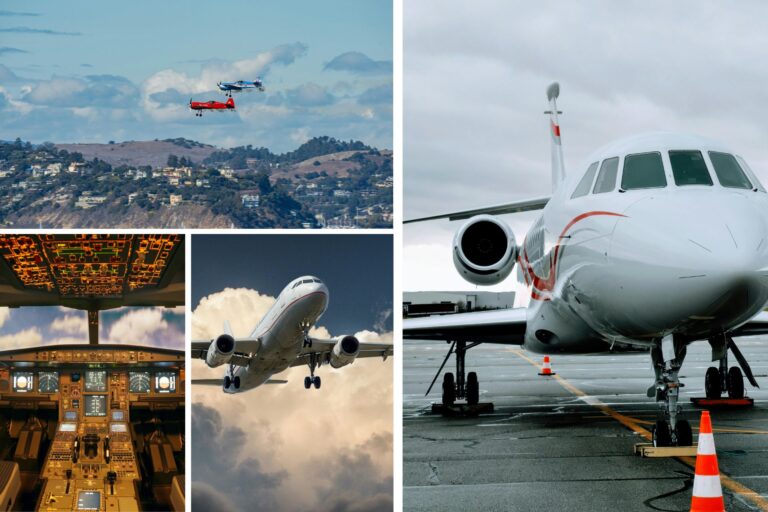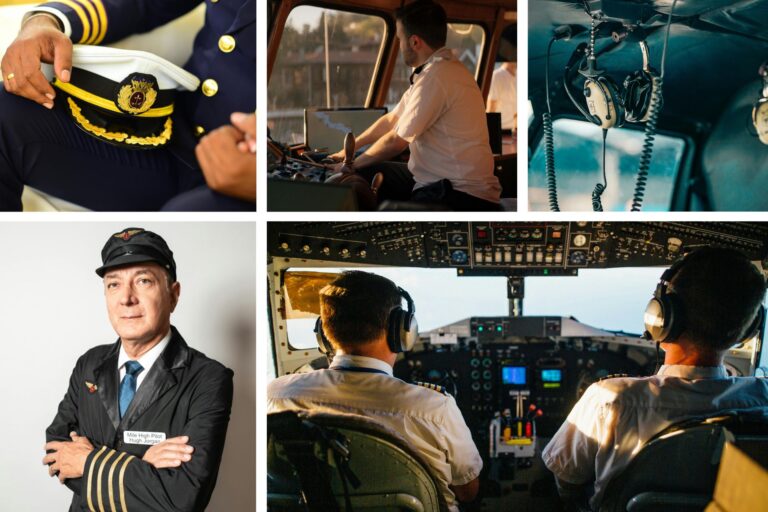How to become a pilot: Learn all the requirements
Is flying an aircraft your dream? If you want to know how to become a pilot, read on and find out about the requirements needed.
If you’ve ever asked yourself how to become a pilot, you’re in the right place to make that dream a reality. Being a pilot is one of the most thrilling and challenging careers out there. It requires not only learning to fly an aircraft but also taking on great responsibility and mastering aviation technology.
In this article, we explain what you need to become a pilot, the different types of licenses, and how to get them. We also cover the most common costs and the schools where you can train to become a skilled professional. This guide will help you turn your passion into a real career.
Requirements to become an airplane pilot
The first step to understanding how to become a pilot is checking whether you meet the main requirements. These include personal, medical, academic, and technical criteria, which can vary slightly from one country to another. Aviation authorities in each region follow the international standards set by the International Civil Aviation Organization, or ICAO, which operates under the United Nations. Here are the key requirements:
- Training: You should have finished high school and have a solid grounding in math and physics.
- Age: You must be at least 17 to start training as a private pilot and 18 to begin training as a commercial pilot. There is no official maximum age, although the ICAO recommends 65 as the upper limit for commercial flying.
- Medical certificate: You will need a Class 1 aviation medical certificate, which assesses your vision, hearing, cardiovascular and neurological health, as well as your overall psychological well-being.
- Languages: English is the international language of aviation, so pilots must meet ICAO’s Level 4 language proficiency to ensure clear communication with air traffic controllers around the world.
- Criminal record: Some countries request this as proof of good conduct.
Types of airplane pilot licenses
There are different types of pilot licenses, depending on the kind of aircraft you want to fly and your career goals. Each comes with its own requirements, privileges, and limitations. Are you aiming to become a commercial pilot, or do you just want to fly occasionally for personal enjoyment? Your choice of license will depend on your goals.
The path to becoming a pilot is organized into different certification levels, which are regulated by ICAO and adapted by national authorities such as EASA in Europe or the FAA in the United States. Here’s an overview of the main types of licenses.
1. Private Pilot License (PPL)
The first license you’ll typically get as a pilot is the PPL, which lets you fly for fun rather than for work. With it, you can operate single-engine planes using visual flight rules, keep an eye on other aircraft and the horizon, and take passengers along without earning money.
- Requirements: Minimum age of 17 and medical certificate 1 or 2.
- Theoretical training: 100 hours of study on meteorology, navigation, flight principles, and communications.
- Required flight hours: At least 45 flight hours, according to EASA regulations.
- Purpose: Serves as a first step before advancing to a commercial license.
2. Commercial Pilot License (CLP)
If your goal is to become a commercial pilot, this is the first professional license you’ll need, as it allows you to be paid for flying. It is the main requirement for working as a co-pilot with airlines, on charter flights, cargo transport, or sightseeing tours.
- Requirements: Minimum age of 18, PPL, Class 1 medical certificate, and advanced theoretical training.
- Theoretical training: Around 250 to 300 hours of advanced classroom instruction covering regulations, aircraft instruments, flight planning, performance, navigation, and weather.
- Required flight hours: Between 150 and 200 hours, depending on the country, including night and cross-country flights.
- Privileges: Qualifies you to work as a co-pilot for airlines or as a pilot for charter, business, or crop dusting flights.

3. Airline Transport Pilot License (ATPL)
This is the highest level of pilot certification and the one you’ll need to serve as captain on a commercial airline flight. With this license, you can fly any type of multi-crew aircraft under instrument flight rules, relying on cockpit instruments, or under visual flight rules, following visual navigation.
- Requirements: Minimum age of 21 in EASA (Europe) or 23 in FAA (USA). In addition, you must have a CPL license, IFR rating, and MEP multi-engine rating.
- Theoretical training: 650 to 750 hours of advanced instruction, covering all technical areas of commercial aviation.
- Required flight hours: At least 1,500 flight hours, including night flying, multi-pilot flying, instrument flying, and flying as pilot-in-command.
- Privileges: You will be able to fly airline aircraft as a captain or first officer. It also qualifies you to be a flight instructor or examiner.
4. Multi-Crew Pilot License (MPL)
Another route to becoming a pilot, and one of the most recent, is the MPL. This program, created by ICAO and EASA, is designed to train pilots specifically for a particular airline. It shortens traditional training by focusing directly on the company’s procedures and needs. The biggest benefit is a very high chance of getting hired by that airline, but the trade-off is that you won’t be able to fly for another carrier.
- Requirements: Minimum age of 18 and Class 1 medical certificate.
- Theoretical training: 750 hours of theoretical instruction.
- Required flight hours: 240 hours in a state-of-the-art simulator and with the actual airline.
- Privileges: You can only be a co-pilot in multi-pilot operations for the airline itself.
Costs of becoming a commercial pilot
One of the most important factors to consider when thinking about becoming a pilot is the cost, as it is one of the most expensive careers out there. Not everyone can afford such a significant investment, and although the high salaries make it worthwhile in the long run, you need to be able to cover the expenses upfront. Below, you’ll find tables with approximate costs for licenses, additional training, insurance, fees, and equipment.
| Training | Details | Cost |
| PPL Theory (Private Pilot License) | 3 to 6 months | $3,000–5,000 |
| CPL Theory (Commercial Pilot License) | 6 to 8 months | $5,000–8,000 |
| ATPL Theory (Airline Transport License) | 9 to 12 months | $10,000–15,000 |
| PPL Flight | 45 hours | $9,000–11,000 |
| CPL Flight | Between 150 and 200 hours | $22,000–42,000 |
| ATPL flight | Up to 1,500 hours | Depends on each airline |
| IFR (Instrument Flight Rating) | Allows flying under instrument rules | $10,000–15,000 |
| MEP (Multi-Engine Piston) | Enables flying multi-engine aircraft | $3,000–5,000 |
| MCC (Multi-Crew Cooperation Course) | Trains coordination between pilot and co-pilot in the cockpit | $3,000–4,000 |
| Upset Recovery Training (UPRT) | Training in recovery from loss of control | $2,000–3,000 |
In addition to these fees, there are other expenses every aspiring pilot must cover, such as equipment, exam fees, and medical certificates.
| Concept | Details | Cost |
| Aviation headphones | Sound insulation and tower communication | $300–1,000 |
| Pilot uniform and accessories | Pants, shirt, badges, belt, shoes | $200–500 |
| Study materials | Books, flight planning apps | $500–1,000 |
| Theoretical and practical exams | Exam fees and license issuance fees | $1,000–2,500 |
| Medical certificate | Class 1 | $300–600 |
| License and rating issuance fees | Required to obtain the license | $100–300 |

In short, becoming a pilot is a major financial commitment, costing anywhere from $90,000 to $120,000. The good news is that, thanks to the high demand for pilots around the world, you can usually recover that investment within a few years. Experienced pilots can earn between $45,000 and $150,000 annually.
Where to study to become an airplane pilot
Choosing a flight school is one of the most important decisions you’ll make, since not all schools provide the same quality of training or international recognition. That’s why it’s essential to understand how to become a pilot and what factors to consider before picking a school:
- Authorized certification: The school must be authorized and audited by EASA, FAA, ANAC, DGAC, or AESA in order to be internationally recognized.
- Type of program: It can be integrated, with theory and training in a single course lasting around 24 months, or modular, which is more flexible and affordable.
- Fleet and simulators: Choose schools with modern aircraft and certified simulators (FNPT II, AATD, FTD, or Full Flight Simulator).
- Reputation and agreements with airlines: A flight school that has partnerships with airlines like Ryanair, easyJet, Emirates, Lufthansa, or Delta will generally offer a higher chance of employment.
- Language and international environment: Studying at a school that offers instruction in English will make it easier to pursue a career with airlines around the world.
When choosing a flight school, reputation and the career opportunities it provides are more important than cost. Remember, this is an investment you’ll want to recover. While scholarships are available, it can be worth paying more for a school that gives you a clear path to a job once you finish your training. Here are some of the top pilot schools:
| School | Location | Advantages |
| CAE Aviation Academy | Oxford, Madrid, Phoenix, Dubai | Agreements with airlines, state-of-the-art Full Flight simulator |
| L3 Harris Airline Academy | United Kingdom and United States | Focus on multi-pilot training and high employability rate |
| Airline Pilot Academy | Spain (Malaga and Seville) | Training in English, modular programs, competitive cost |
| ATP Flight School | United States | Intensive instruction and opportunity to work in the U.S. |
| Emirates Flight Training Academy | Dubai | Emirates Airlines’ own school |
How to connect to the internet as an airplane pilot
As a pilot, you’ll need reliable internet to check flight plans, monitor the weather, share aviation documents, and stay in touch with family and friends. One common challenge for aviation professionals is the extra cost of international roaming.
That’s why Holafly’s monthly plans can be a real lifesaver while traveling. With a global eSIM, you can stay connected in over 170 countries without worrying about roaming fees or swapping SIM cards when you cross borders. Plus, setting it up is simple and can be done in just a few steps through the app.
You can choose between a 25 GB plan or unlimited data, with 5G coverage and the ability to connect multiple devices at the same time. Forget hunting for Wi-Fi at every airport and enjoy your flight completely stress-free!
Frequently asked questions about becoming an airplane pilot
It can take between 18 and 36 months in total, including theoretical training, flights, and exams.
A college degree is not required; finishing high school is enough. However, a background in engineering or science can give you an advantage and help you move into higher level positions within an airline.
Some of the countries known for the best aviation training include the United States, Spain, the United Kingdom, Canada, and Australia. These destinations have schools certified by EASA in Europe or the FAA in the United States, and their programs are recognized internationally by commercial airlines.
A commercial pilot is allowed to fly for a salary, while a private pilot flies only for personal enjoyment.





 Language
Language 


















 No results found
No results found


